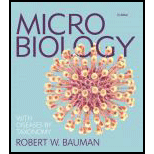
To determine:
The differences between the pathogenicity of coliform, noncoliform, and truly pathogenic enteric bacteria.
Introduction:
The pathogenicity in Enterobacteria is affected by various factors like: Exotoxins, which leads to symptoms like diarrhea. Fimbriae and adhesion, which help the bacteria to adhere to host cells. A polysaccharide capsule prevents the cell from phagocytosis and antibodies. Iron binding compounds. Type III secretion system, synthesizes polypeptides. Lipooligosaccharides in the outermost membrane of the cell wall, which consists of Lipid A that causes symptoms like fever and dilation of blood vessels. Hemolysin breaks down red blood cells in the host.
Pathogenic members of the family Enterobacteriaceae are categorized into three groups:
Coliforms: These are pathogens which are opportunistic and can ferment lactose at a very fast rate. They are found in the usual microbial habitat. For example: E. coli, Klebsiella, and Citrobacter.
Noncoliforms: These too are pathogens which are quite opportunistic and do not ferment lactose. They are also found in the usual microbial habitat. For example: Proteus, Morganella, and Providencia.
True pathogens: These bacteria do not ferment lactose and don’t live in the usual habitat of microbes. They have many virulent factors which make them always pathogenic. For example: Salmonella, Shigella, and Yesinia.
Want to see the full answer?
Check out a sample textbook solution
Chapter 20 Solutions
Microbiology with Diseases by Taxonomy (5th Edition)
- Describe three cranial and postcranial features of Neanderthals skeletons that are likely adaptation to the cold climates of Upper Pleistocene Europe and explain how they are adaptations to a cold climate.arrow_forwardBiology Questionarrow_forward✓ Details Draw a protein that is embedded in a membrane (a transmembrane protein), label the lipid bilayer and the protein. Identify the areas of the lipid bilayer that are hydrophobic and hydrophilic. Draw a membrane with two transporters: a proton pump transporter that uses ATP to generate a proton gradient, and a second transporter that moves glucose by secondary active transport (cartoon-like is ok). It will be important to show protons moving in the correct direction, and that the transporter that is powered by secondary active transport is logically related to the proton pump.arrow_forward
- drawing chemical structure of ATP. please draw in and label whats asked. Thank you.arrow_forwardOutline the negative feedback loop that allows us to maintain a healthy water concentration in our blood. You may use diagram if you wisharrow_forwardGive examples of fat soluble and non-fat soluble hormonesarrow_forward
- Just click view full document and register so you can see the whole document. how do i access this. following from the previous question; https://www.bartleby.com/questions-and-answers/hi-hi-with-this-unit-assessment-psy4406-tp4-report-assessment-material-case-stydu-ms-alecia-moore.-o/5e09906a-5101-4297-a8f7-49449b0bb5a7. on Google this image comes up and i have signed/ payed for the service and unable to access the full document. are you able to copy and past to this response. please see the screenshot from google page. unfortunality its not allowing me attch the image can you please show me the mathmetic calculation/ workout for the reult sectionarrow_forwardIn tabular form, differentiate between reversible and irreversible cell injury.arrow_forwardhelparrow_forward
- Can you please help me answer these questions?arrow_forwardSkryf n kortkuns van die Egyptians pyramids vertel ñ story. Maximum 500 woordearrow_forward1.)What cross will result in half homozygous dominant offspring and half heterozygous offspring? 2.) What cross will result in all heterozygous offspring?arrow_forward
 Microbiology for Surgical Technologists (MindTap ...BiologyISBN:9781111306663Author:Margaret Rodriguez, Paul PricePublisher:Cengage LearningEssentials of Pharmacology for Health ProfessionsNursingISBN:9781305441620Author:WOODROWPublisher:Cengage
Microbiology for Surgical Technologists (MindTap ...BiologyISBN:9781111306663Author:Margaret Rodriguez, Paul PricePublisher:Cengage LearningEssentials of Pharmacology for Health ProfessionsNursingISBN:9781305441620Author:WOODROWPublisher:Cengage Comprehensive Medical Assisting: Administrative a...NursingISBN:9781305964792Author:Wilburta Q. Lindh, Carol D. Tamparo, Barbara M. Dahl, Julie Morris, Cindy CorreaPublisher:Cengage Learning
Comprehensive Medical Assisting: Administrative a...NursingISBN:9781305964792Author:Wilburta Q. Lindh, Carol D. Tamparo, Barbara M. Dahl, Julie Morris, Cindy CorreaPublisher:Cengage Learning





